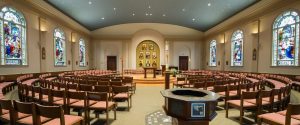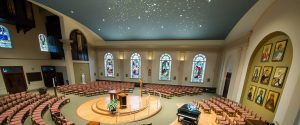Project Summary:
The renovation of this early twentieth century Church to meet current liturgical needs has been recognized with a 2016 Preservation Initiative Award winner as well as receiving recognition by Faith and Form magazine. To highlight the new floor plan and glorious trompe l’oeil ceiling, Rambusch installed new single- and multi-element LED downlights, accents and uplighting. No ceiling work needed, as all work was done from above. Energy expenses and maintenance costs have been greatly reduced.
Project Detail:
Decorative ceilings add grandeur and splendor to almost any spiritual environment, and they are a tradition in religious architecture stretching back millennia. Decorated ceilings are priceless features of the modern sanctuary, especially when their surfaces have remained intact, vivid and in otherwise fine shape. It is always best to disturb them as little as possible.
The deep blue star field above the Church of St. Vincent de Paul had been in service for decades, yet in 2014 the parish desired to enhance its worship space and at the same time upgrade the entire lighting system, but with minimal disturbance to surface finishes.
To save cost and ensure the safety of the décor, Rambusch built new LED units to mount on to the existing downlight trim rings, which were original Rambusch equipment from the 1970’s. The complete re-installation occurred from above, ensuring the ceiling’s safety. To augment the new system, LED surface accents were also built and installed to highlight the new altar and surrounding predella. To celebrate the ceiling and expand the entire visual experience of the worship space, the finishing touch was to refurbish the existing uplight locations with our patented, high-conductivity LED engines. A Lutron multi-scene dimming system controls the installation.
The project won the 2015 Faith & Form/IFRAA Religious Art and Architecture Award under the category of Religious Architecture, Renovation. By reconfiguring and sensitively enhancing its worship space, St. Vincent de Paul’s continues the mission it began in 1908.

